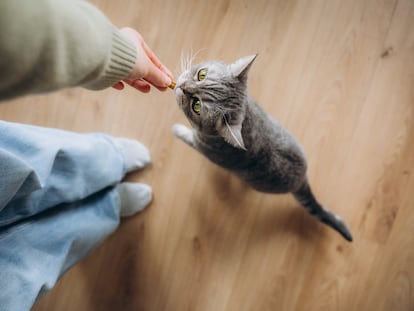Barbie vs chimpanzees: why don’t boys play with dolls more?
Studying how other primates play can help us understand why male children prefer toys that have wheels

In 2018, I traveled with three companions to a small island in the Quimbas archipelago, in Mozambique. Our objective was to research a population of monkeys (Cercopithecus mitis) that lived there: we were primatology students writing our master’s theses.
I remember the emotion we felt when — after three months without a drop falling — the first rains arrived. The forest became greener, the trees filled with fruit and the monkeys finally got a break from the sweltering heat. The babies began to play and the females started giving birth. Almost every morning, we discovered a newborn baby.
One day, we were following one of the mothers, when we observed a behavior that caught our attention: there was a juvenile monkey (whose sex we couldn’t identify) who followed a mother insistently. It wanted to smell her baby, touch it, inspect its genitals — and even tried to steal it! When the mother wouldn’t let the juvenile monkey touch her newborn, it would yell in frustration. Eventually, after giving up, the juvenile picked up a stone from the ground with one hand and, for a few minutes, carried it close to its belly, in the same way that a mother monkey carries her newborn.
Eight years earlier, primatologists Sonya Kahlenberg and Richard Wranham had published a paper describing similar behavior in chimpanzees. Young chimpanzees in Uganada’s Kibale Forest National Park often hold rocks or logs like newborn babies. Sometimes, they take these objects to the nest where they sleep. They may even build a nest for the object.
Kahlenberg and Wranham reported that young females engaged in these behaviors significantly more frequently than males: up to three to four times as often. In addition, the males were less delicate, since they often kicked the stone in the same way that they kick when playing with each other.
A possible explanation for this difference between the sexes is that the females generally had a greater propensity to use objects. However, this wasn’t the case. Young males love to play with sticks and stones, using them as weapons. Rather, the authors proposed that the differences could be due to females’ greater interest in practicing baby care. In fact, as soon as the female chimpanzees had their first baby, they didn’t behave like this anymore.
There are also other reports of female primates playing with “dolls.” For example, in 2022, the famous primatologist and science writer Frans de Waal published a book titled Different: What Apes Can Teach Us About Gender. The first chapter — which deals with how boys, girls and other primates play — begins with the following anecdote: “One morning, through my binoculars, I saw Amber heading towards the island in a strange hunched posture, limping on one hand and two legs. With her other hand, she hugged the head of a horsehair brush to her belly, just as a mother chimpanzee holds a newborn that is too small and weak to hold itself. Amber was an adolescent female from the Burgers Zoo chimpanzee colony. One of the keepers must have left the brush behind, and Amber had removed the handle. Occasionally, she would groom herself and wander around with the brush perched on her rump, like a mother carrying a more grown-up offspring.”
In human infants we find a pattern similar to that in chimpanzees: girls play with dolls much more than boys do, across all cultures. Undoubtedly, from a young age, we learn that some activities are more socially acceptable depending on our gender: boys who play with dolls are often stigmatized. However, observations with primates indicate that there may also be a biological basis.
To verify this, back in 2008, an experiment was carried out at the Yerkes National Primate Research Center at Emory University with macaques (Macaca mulatta). Thirty-nine infants were given different objects to play with. Some were toys commonly associated with boys — such as balls, tractors and other objects with wheels — and others were doll-like stuffed animals, which we usually associate with girls. The result was that, just like in humans, males preferred wheeled toys to stuffed animals, while females showed no preference.
This result is striking, especially if we take into account that macaques don’t have this type of object in their natural habitat. In a large number of mammalian species, each sex plays differently: males tend to play more dynamically and roughly than females. Therefore, it’s possible that toys with wheels allowed macaques to develop this type of play better than stuffed animals.
If two young male macaques or chimpanzees play with a doll, the doll will most likely be destroyed. They will each grab one end and pull it in a fight for the item, showing who is the strongest. On the contrary, the females will tuck the doll in and inspect its genital area. They are more prone to care.
These differences in play have also been observed in humans. Boys are more energetic, while girls tend to use narrative games more. Therefore, it’s possible that boys and girls have different toys because they choose those that allow them to better develop their preferred style of play. In 1982, an American study conducted a survey to find out the reasons why children chose toys: 55% talked about what they could do with these toys, compared to 1% who made reference to their gender.
Of course, this isn’t to say that your cultural environment doesn’t affect you. One of the favorite toys of the male macaques in the experiment was a miniature shopping cart… but this isn’t a popular toy among boys, probably because of the imagery associated with it.
It’s important to clarify that we’re speaking in general terms — there are always exceptions. For example, in utero exposure to sex hormones influences toy preferences. Girls with CAH — who secrete more androgens than normal — play more like boys and also choose typically masculine toys more often. This is despite the fact that, from a young age, they are encouraged to use supposedly feminine toys. Perhaps we adults have less power over the games that our sons and daughters choose than we think.
Sign up for our weekly newsletter to get more English-language news coverage from EL PAÍS USA Edition
Tu suscripción se está usando en otro dispositivo
¿Quieres añadir otro usuario a tu suscripción?
Si continúas leyendo en este dispositivo, no se podrá leer en el otro.
FlechaTu suscripción se está usando en otro dispositivo y solo puedes acceder a EL PAÍS desde un dispositivo a la vez.
Si quieres compartir tu cuenta, cambia tu suscripción a la modalidad Premium, así podrás añadir otro usuario. Cada uno accederá con su propia cuenta de email, lo que os permitirá personalizar vuestra experiencia en EL PAÍS.
¿Tienes una suscripción de empresa? Accede aquí para contratar más cuentas.
En el caso de no saber quién está usando tu cuenta, te recomendamos cambiar tu contraseña aquí.
Si decides continuar compartiendo tu cuenta, este mensaje se mostrará en tu dispositivo y en el de la otra persona que está usando tu cuenta de forma indefinida, afectando a tu experiencia de lectura. Puedes consultar aquí los términos y condiciones de la suscripción digital.
More information
Archived In
Últimas noticias
Tiger Woods turns 50: Will he continue playing on the PGA Tour or take a back seat?
The surreal journey of James Nnaji, the Barcelona youth player selected in the NBA Draft who ended up in the NCAA
Trump claims peace in Ukraine is near, but Moscow suggests otherwise
A survivor’s account of the Interoceanic Train accident: ‘We were scared because of the speed on the curve’
Most viewed
- Oona Chaplin: ‘I told James Cameron that I was living in a treehouse and starting a permaculture project with a friend’
- Reinhard Genzel, Nobel laureate in physics: ‘One-minute videos will never give you the truth’
- Why the price of coffee has skyrocketed: from Brazilian plantations to specialty coffee houses
- Pablo Escobar’s hippos: A serious environmental problem, 40 years on
- Chevy Chase, the beloved comedian who was a monster off camera: ‘Not everyone hated him, just the people who’ve worked with him’











































